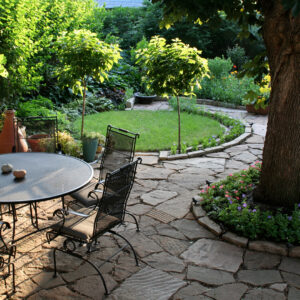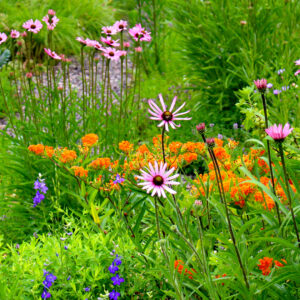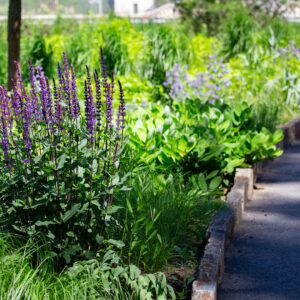The American Obsession
What is America’s obsession with lawns? It can be attributed to both historical and cultural factors.
Lawns hold a fascinating and ancient history. Who knew? As far back as 3000 BCE, in Mesopotamia, the concept of open green spaces around homes and temples emerged. The wealthy Babylonians and Assyrians cultivated grassy areas using irrigation systems.
The idea of manicured lawns began to take root during the Renaissance period in Europe. European aristocrats and wealthy landowners started cultivating grassy areas near their estates, often for recreational purposes like lawn bowling or as a backdrop for elaborate gardens. The tradition of the lawn was brought to North America by European settlers. Initially, lawns were limited to wealthy estates and public parks. However, by the 19th century, the rise of suburbanization and the emergence of the middle class led to more widespread lawn cultivation.
In the 20th century, the American suburbs played a significant role in popularizing the idea of the suburban lawn. The post-World War II housing boom saw the proliferation of single-family homes with neatly manicured lawns, reflecting ideals of prosperity, order, and suburban living. In the latter half of the 20th century, maintaining a lush, green lawn became ingrained in American culture. The advent of lawnmowers, sprinkler systems, and chemical fertilizers made it easier for homeowners to achieve the perfect lawn.
Americans have traditionally viewed lawns as a:
- Sign of Prosperity – It’s associated with the idealized image of suburban life, where homeowners take pride in maintaining their properties to reflect a certain standard of living.
- Status Symbol – Historically, having a well-manicured lawn symbolized wealth and social status. As suburbs expanded and the middle class grew, having a neat lawn became a way for homeowners to showcase their success and upward mobility.
- Community Expectation – There’s a sense of social pressure within many American neighborhoods to keep up with the Joneses. Maintaining a tidy lawn is often seen as fulfilling a societal expectation and fitting in with community norms.
- Recreational Necessity – Lawns provide space for outdoor activities and leisure. Whether hosting backyard barbecues, playing sports like soccer or Frisbee, or simply lounging in the sun, lawns offer a versatile outdoor living space that many Americans value.
- Cultural Influence – The concept of the perfect lawn has been perpetuated through various forms of media, including advertising, television shows, and movies. These depictions often reinforce the idea that a well-kept lawn is essential for a happy, successful suburban life.
- Connection to Nature – Despite being a cultivated landscape, lawns are often associated with nature and the outdoors. Many people find solace in spending time in green spaces, and a well-maintained lawn provides a sense of tranquility and connection to the natural world.
Modern Lawns
While the American obsession with lawns has deep historical and cultural roots, there’s also a growing awareness of the personal and environmental impact of traditional lawn care practices.
Evolving lifestyle choices, allocation of household funds, and personal time management all play a role in the changing suburban landscape and our love of lawns. Making an even greater contribution to this change are environmental concerns such as water usage, pesticide and herbicide contamination, fertilizer runoff, air and noise pollution caused by gas-powered lawn tools, and a new understanding of the need for biodiversity. All have prompted a reassessment of traditional lawn care practices. As a result, many homeowners are exploring native alternatives or reducing the size of their lawns in favor of more sustainable and eco-friendly options.
Transitioning Away From Traditional Lawns
Transitioning from a traditional lawn to a more environmentally friendly and sustainable landscape using native plants is a great idea. Here are some ideas to get started:
- Evaluate Your Space: The first step in transitioning away from a traditional turf is to assess the amount of lawn space that you actually use and need. Traditional turf is still the clear choice for areas where lawn games are enjoyed, outdoor pet use, and such. Turn unimportant or unused traditional turf areas into native gardens. If you find a large, serene expanse of turf pleasing, consider replacing it with a native meadow or a no-mow native grass alternative.
- Choose Native Plants: Research native plants well-suited to your region’s climate and soil conditions. Look for species that require minimal maintenance, attract pollinators, and provide habitat for local wildlife. Consider a mix of ground covers, grasses, wildflowers, shrubs, and trees to create a diverse and resilient ecosystem.
- Plan Your Design: Sketch out a design for your new landscape, taking into account the natural contours of the land, existing structures, and any focal points you want to highlight. Group plants with similar water and sunlight needs together to optimize growing conditions and minimize maintenance. Employing a native plant landscape company will help move the transition along at a quicker pace while ensuring expertise in design, plant selection, and ongoing care.
- Consider Traffic Patterns: Areas with heavy traffic patterns may be replaced with stone or gravel walkways and pathways through the native landscape gardens. Grassy gathering areas, such as those used for entertaining and grilling, may be replaced with a natural stone patio.
- One Step at A Time: Depending on the size of your property, transitioning away from a traditional lawn and landscape to a native one can be overwhelming and costly. However, the long-term benefits for the greater good will outweigh these initial drawbacks. One solution is to install your plan one step at a time. Once you have your design, you may chunk out the project, accomplishing it in steps over time.
- Prepare for Planting: Before planting, prepare the soil by removing existing turf and weeds. Consider using environmentally friendly methods such as sheet mulching or solarization to smother weeds and existing lawn. Amend the soil with organic matter like compost or leaf mulch to enhance fertility and drainage.
- Plant Native Species: Start by planting larger trees and shrubs, then fill in the remaining areas with ground covers, grasses, and wildflowers. Be sure to space plants according to their mature size and growth habits to avoid overcrowding. Water newly planted specimens regularly until they become established, then gradually reduce irrigation to encourage deep root growth.
- Mulch and Maintain: Apply a layer of organic mulch such as wood chips, tree leaves, or pine straw around newly planted areas to suppress weeds, retain moisture, and regulate soil temperature. Monitor your landscape regularly for signs of pests, disease, or drought stress, and address any issues promptly using natural or organic methods.
Even today, the lawn continues to be a staple of suburban landscapes, albeit with a growing emphasis on sustainability, biodiversity, the addition of more native plants, and alternative landscaping practices. From its origins in ancient civilizations to its evolution in modern society, the history of lawns reflects changing cultural values, social norms, and environmental awareness. It’s time to reduce our American obsession with lawns, change with the times, and consider transitioning to low-maintenance, environmentally friendly, sustainable lawn and landscape alternatives.






